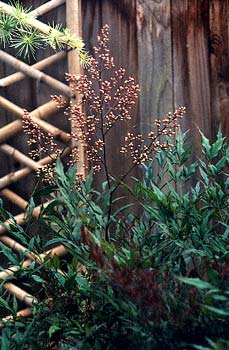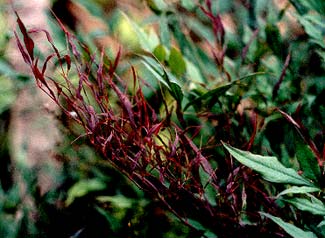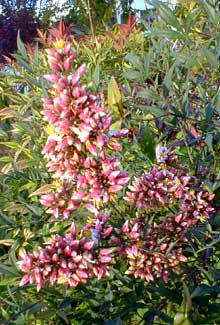
'Monum' or "Plum Passion"
Heavenly Bamboo,
aka Sacred Bamboo,
aka Nanten
"Down bamboo-stalks the sunbeams slide,
Darting like glittering elves at play,
To the thin arched grass where crickets hide
And sing all day."
-from "Sunset on the Hills of Satsuma"
Mary McNeil Fenollosa
(fl. 1890s
Mary McNeil Fenollosa
(fl. 1890s
The locally ubiquitous garden shrub Heavenly Bamboo (Nandina domestica) is not a bamboo but has leaves that resemble bamboos. It's actually of the barberry family, & is the only species in its genus.
In our garden, the first one we planted more than doubled its size in three years, & got to be over six feet tall, counting the sprays of small white flowers that stand upward from the top. Round about its fifth year it had to be transplanted & was dramatically pruned for the first time, & immediately recovered with new tall branches.
 The variety shown on this page is the cultivar named 'Monum' but it is marketed under the trademarked name "Plum Passion," by which name it is better known.
The variety shown on this page is the cultivar named 'Monum' but it is marketed under the trademarked name "Plum Passion," by which name it is better known.The leaves are of mixed colors, some being a dull green, but then the occasional branch of newer leaves has entirely of plum-purple leaves, as shown in the second July (2002) portrait.
The tendency for one entire branch of 'Monum' to be purple, with the branches around it green, is a very interesting effect. Then in late autumn & winter more of the branches turn bronzy or purple.
We also have an unnamed Plain Heavenly Bamboo that is paler green without the purple shades, & it is shown on its own page.
For the first two years in the ground I frankly half regretted planting 'Monum,' as it just wasn't as elegant as I had imagined it ought to be, the limb structure being somehow weak, by my aesthetic.
 At some point, however, it was large enough, with substantial enough trunk, it really began to contribute to the "bones" of the garden. I now like it a lot, & it provides protection for semi-shade loving perennials beneath it.
At some point, however, it was large enough, with substantial enough trunk, it really began to contribute to the "bones" of the garden. I now like it a lot, & it provides protection for semi-shade loving perennials beneath it.Nandina thrives in considerable shade, but has a tendency to become leafless underneath unless it can get sunlight around the lower part of the plant. Before I translplanted this one, it was in a lot of shade, & needed to be staked because it became top-heavy. This did not necessarily harm its looks, because the species' tendency to lose leaves at the bottom gives it the appearance of a miniature tree with long trunk, & I used the "empty" space around its base for small ferns. But when transplanted to a sunnier garden, it became more broadly bushy & the trunk became stronger, no longer needing to be staked.
Puget Sound weather seems to suit it ideally, as it is perfectly evergreen throughout the winter. It is known to die to the ground in places with winter temperatures to five degrees or zero, & is deciduous at about ten degrees. It's never so cold as that here, & the leaves show little or no winter injury. I don't think I would care for it in climates where it behaves as a die-back perennial, because to me it's primary charms develop when the branches are thick & old enough to gain character.
The loose, somewhat pyramidal sprays of flowers are white with pinkish cast & have yellow anthers. These panicles look delicate but are actually very stiff & hard & last even through the winter. Ours blooms strongly July through August. The hard flower buds shown at top of this page is a photo from June's end (2004), before the blooms opened. It usually reblooms in Autumn. The third photo shows a panicle at mid-October just as the flowers are opening. These panicles have been denser since moving it to the sunnier garden.
Nandina can produce big (one-third inch) bright red autumn/winter berries. These are edible, but not especially tasty, so are best left on the shrub, as they will remain decorative through the whole of winter & even into the following spring. Each berry has two seeds; the seeds are mildly toxic, probably not more so than apple seeds, as there has never been a case of people being harmed by eating Nandina berries.
Our "Plum Passion" as of 2003 had never produced these fruits, for this shrub needs to be planted in a group for sake of cross-pollination before it will produce the showy berries. So in 2003 we planted a more or less "wild" form (or an unnamed cultivar) next to the "Plum Passion."
Before we had the second variety of nandina for cross-pollination, the panicals of flowers dried upon the bush, & were were quite beautiful long into the following year. Now that there are two of them planted together, they produce bright red late-autumn & winter berries which remain vibrant for several months, being a mite too hard for most birds' liking.